
Home |
||
|---|---|---|
Before the exhibitions |
Eight Impressionism exhibitions |
After the exhibitions |
|
||
Barbizon
Forest of Fontainebleau
****
Jean-François Millet
The term "Barbizon School" is often used, but this is rather misleading. The artists summarised by this term were never a self-contained group or a school of painting, so perhaps the term "artists' colony" would be more appropriate. Some of the artists in the group settled in Barbizon or the surrounding area for long periods of time, while others only stayed there temporarily or sporadically in the summer.
It should also be noted that they were not a group with a fixed artistic or theoretical programme. There are no joint treatises on art; they would have been too different in their artistic views for that.
However, it was one of the first groups of French artists to break free from the rigid academic tradition of the then powerful official academies: a common rejection of academic classicism in the subject matter of landscape, but not so much in technique or style. They were more artistic individualists who sought new paths and fought for new pictorial content.
Théodore Etienne Pierre Rousseau
* 15. 4. 1812 in Paris; † 22. 12. 1867 in Barbizon
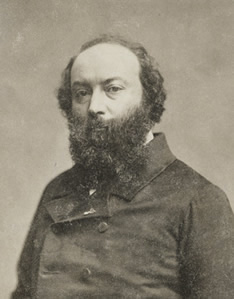
Photo by Nadar
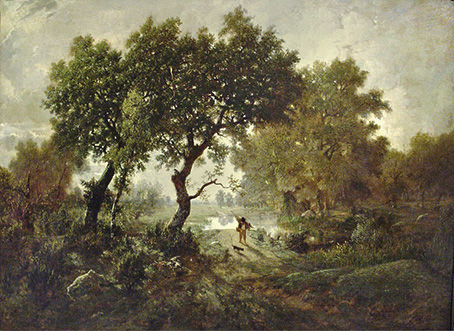
Le pêcheur, tôt le matin - Le Grand Refusé
ca. 1865 - 99 x 134 cm - Oil on canvas
Norton Simon Museum of Art, Pasadena, USA >
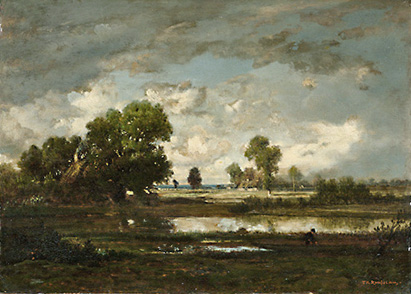
La mare: ciel orageux
ca. 1865-67 - 22,6 x 31,2 cm - Oil on wood
Musee d'Orsay, Paris, France >
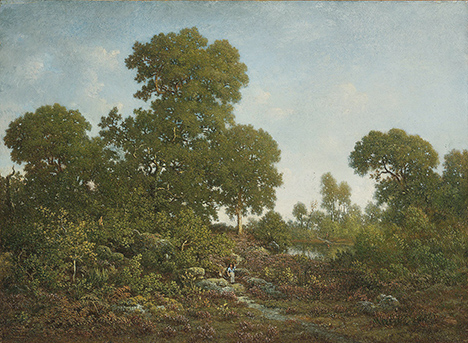
Printemps
vor 1865 - 42 x 54 cm - Oil on canvas
Art Institut of Chicago, USA >
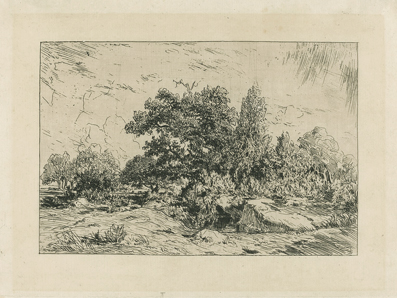
Vue du Plateau de Bellecroix
1849 - 20,5 × 13,8 cm - Etching
The group of Barbizon painters includes in particular
Theodore Rousseau
(he is regarded as the founder of the "Paysage intime" and was one of the first open-air painters. In his precise depictions of the landscape, Rousseau endeavoured to capture its mood and reproduce it realistically)
Charles-François Daubigny
(with harmoniously lighter works that attempt to show a lot of spontaneous and immediate landscape experience),
Constant Troyon
(developed a mastery in the depiction of animals in the landscape)
Narzisse Diaz De La Peña
(painted many landscapes from Fontainebleau, which he decorated with figures)
und Jules Dupré
(alongside Rousseau, the main representative of the Paysage Intime, depicting a landscape in his own mood in colour and light).In the broadest sense, depending on how you look at it, Jean-François Millet, Camille Corot and Gustave Courbet are also associated with the above painters, as they were also occasionally in Barbizon and worked and discussed with the others.
Charles-François Daubigny
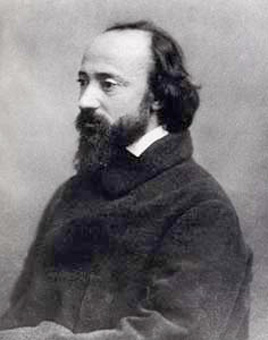
* 15. 2. 1817 in Paris; † 19. 2. 1878 in Paris
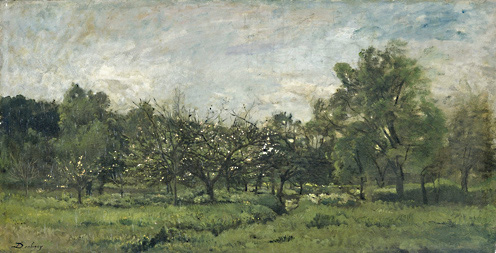
Orchard
1865/69 - 55 x 107 cm - Oil on canvas
Rijksmuseum Amsterdam, Netherlands >
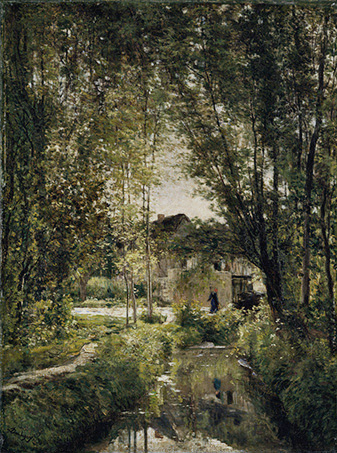
Paysage avec un flux ensoleillé
ca. 1877 - 64 x 48 cm - Oil on canvas
Metropolitan Museum of Art, New York, USA >
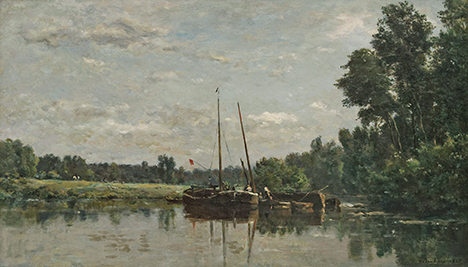
Les Péniches
1865 - 38 x 67 cm - Oil on canvas
Louvre, Paris, France >
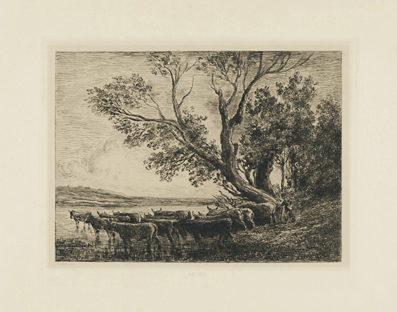
Le Gué
1865 - 33,7 × 25,2 cm - Etching and drypoint
They each had their own role models, for example in Dutch painting, such as that of Jacob van Ruisdael, or in the English painters John Constable, William Turner and Richard Parkes Bonington. It is also interesting to note the Barbizon painters' intensive knowledge of and great admiration for Japanese painting by Hiroshige or Hokusai, which was emerging in Europe at the time.
The Barbizon painters endeavoured to trace the true character of a landscape in open-air painting, to study everything in detail and - even before the Impressionists - to capture the light of the moment! But not to make it a main theme, like Monet or others. However, they must be seen as forerunners of the Impressionists, even if they still differed significantly in their artistic views from those of their more 'famous' successors.
From an academic point of view, plein-air painting was clearly defined at the time as practice work, as a preparatory study for the large paintings of the ideal landscape to be composed in the studio. In contrast to this, the young painters contrasted their work with the emotionally perceived intimate detail of nature in the new view of the 'paysage intime'.
For technical reasons, oil painting was still mostly confined to the studio in the early years of the century, as transporting, storing and handling the colours outdoors was very difficult. In 1841, colours were produced in tubes for the first time, which made it much easier to work outdoors and thus heralded an innovation in artistic work and changed open-air painting. The inventor of these tube colours was the American John Rand, who as a painter was annoyed by dried oil paints and therefore applied for a patent for tubes. The company Winsor & Newton, London, adopted the method in the same year, 1841, and produced colours in tubes.
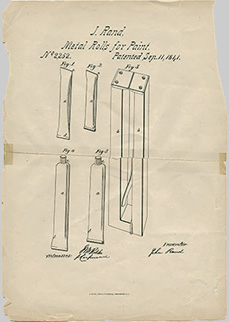
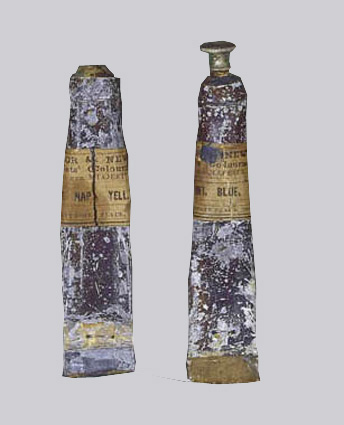
Jules Dupré
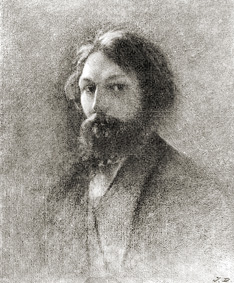
* 5. 4. 1811 in Nantes; † 6. 10. 1889 in L'Isle-Adam
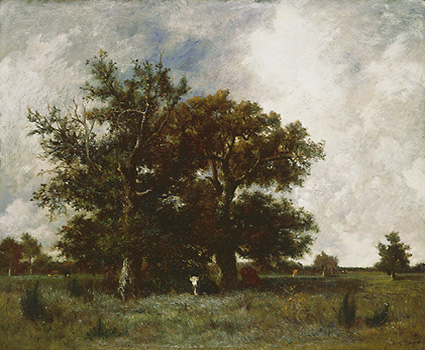
Fontainebleau chênes
ca. 1840 - 81 x 99 cm - Oil on canvas
Minneapolis Institute of Art, Minneapolis, USA >
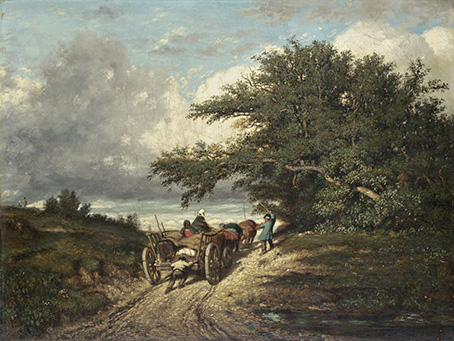
Sur la route
1856 - 39 x 50 cm - Oil on canvas
Art Institute of Chicago, USA >
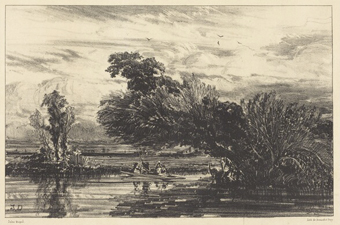
Les bords de Somme
1836 - 21,3 × 13,8 cm - Lithography
As different as the artists who worked at Barbizon were, they all had a significant influence on modern painting and paved the way by breaking away from the deadlocked, outdated traditions of the academies and breathing new life into art. These were landscapes and situations from the times, no longer idealised landscapes as before. The Impressionists developed the ideas further... Everything flows!
Constant Troyon
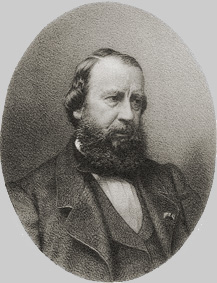
* 28. 8. 1810 in Sévres bei Paris; † 21. 2. 1865 in Paris
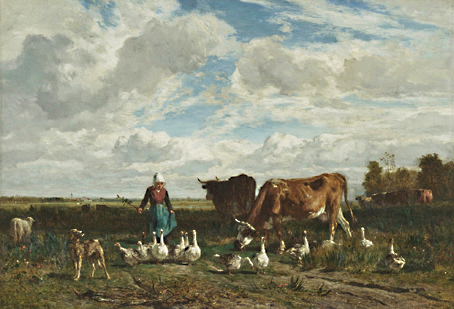
Le Pâturage à la gardeuse d'oies
1854 - 80 x 117 cm - Oil on canvas
Musée d'Orsay, Paris, France >
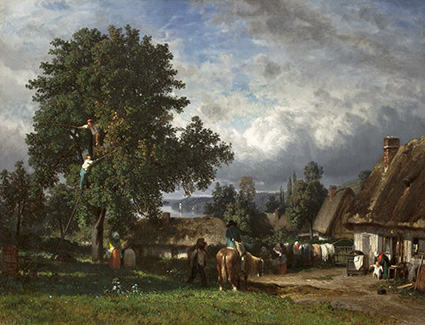
Récolte de pommes en Normandie
ca. 1835-65 - 61 x 81 cm - Oil on canvas
Worchester Art Museum, Worchester, USA >
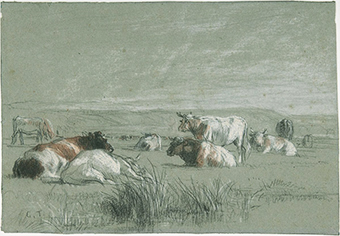
Vaches dans un paysage
ca. 1840/50 - 19,8 x 28,9 cm - Black, white and red chalk, on blue-green paper
Metropolitan Museum of Art, New York, USA >
Narcisse Diaz De La Peña
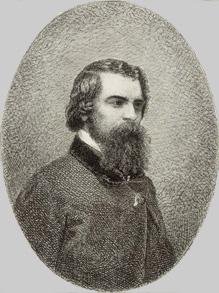
* 20. 8. 1807 in Bordeaux; † 18. 11. 1876 in Menton
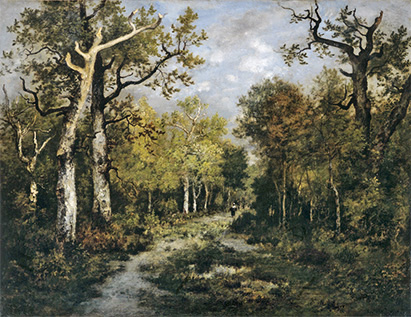
Le Matin, forêt de Fontainebleau, sous-bois
1867 - 72 x 93 cm - Oil on canvas
Musée des Beaux-Arts, Bordeaux, France >
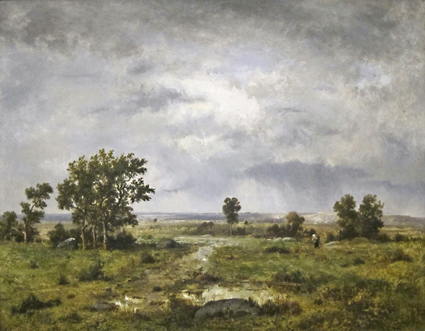
Marche de Vallée
1872 - 58 x 74 cm - Oil on wood
Cincinnati Art Museum, Cincinnati, USA >
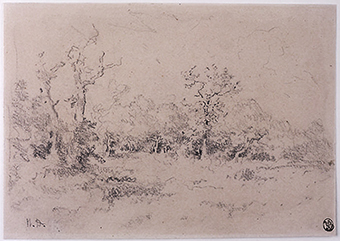
Dégagement forestier
1856/76 - 15,3 x 21,5 cm - Graphite and coloured pencil on firm wove paper
Metropolitan Museum of Art, New York, USA >
*****
Jean-François Millet
.jpg)
* 4. 10. 1814 im Weiler Gruchy / Gréville-Hague;
† 20. 1. 1875 in Barbizon
Jean-François Millet, born in Normandy, is always mentioned together with artists such as Rousseau, Dupré and Daubigny. However, this was more due to the fact that he lived with his family in Barbizon for several years from 1849. However, his intentions in art were initially very different from those of his colleagues there.
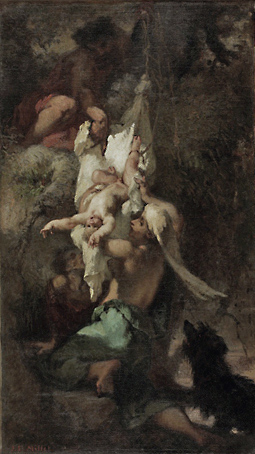
Œdipe enlevé de l'arbre
1847 - 136 x 78 cm - Oil on canvas
National Gallery of Canada, Ottawa, Canada >
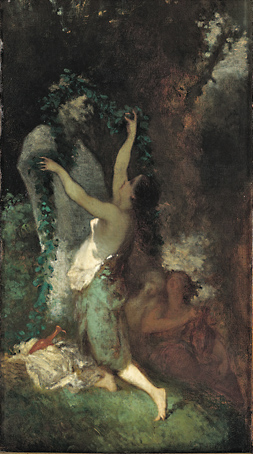
L'offrande à Pan
1845 - 52 x 29 cm - Oil on canvas
Musée Fabre, Montepellier, France >
Initially, he painted portraits and mythological scenes, which were popular at the time. He then focussed on peasant life. The painting 'un Vanneur' was a sensation at the Paris Salon and earned him the reputation of a revolutionary, a categorisation that he himself did not like at all.
.jpg)
Un vanneur
(eine von mehreren Varianten)
ca. 1847/48 - 101 x 71 cm - Oil on canvas
National Gallery, London, United Kingdom >
Like this motif, he also painted one of his most famous pictures, the Corn Readers, several times; the version from 1853 has slight impressionistic traits.
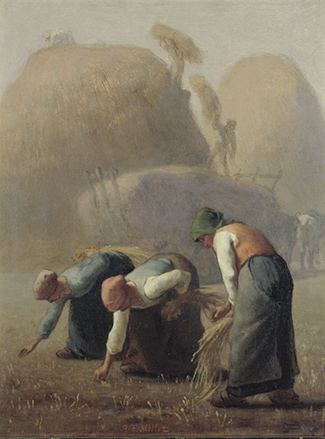
L’Eté, les glaneuses
1853 - 38 x 29,5 cm - Oil on canvas
Yamanashi Prefectural Museum of Arts, Kofu, Japan >
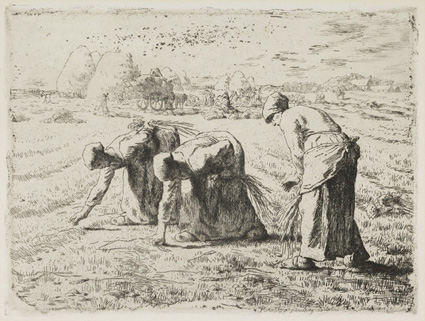
Des glaneuses
ca. 1857 - 19 x 25 cm - Etching

Des glaneuses
1857 - 83 x 110 cm - Oil on canvas
Musée d'Orsay, Paris, France >
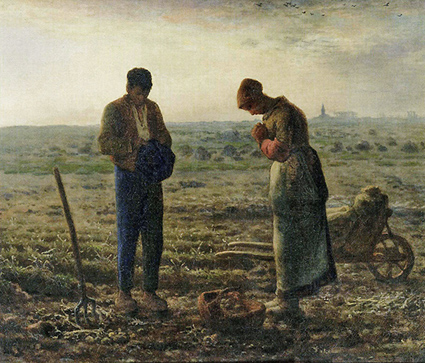
l'Angélus
1857/59 - 55 x 66 cm - Oil on canvas
Musée d'Orsay, Paris, France >
It was only later, from 1863 onwards, that he turned exclusively to landscape painting, which was typical of the Barbizon painters and whose treatment of light in his pictures brought him close to the Symbolists. He produced many pastel drawings, which unfortunately are not often seen. During this period, he was awarded the Order of the Legion of Honour.
Le Briquet
ca.
1866 - 43,5 x 52,7 cm - Pastel and black chalk on yellowish paper
Hammer Museum, Los Angeles, USA >
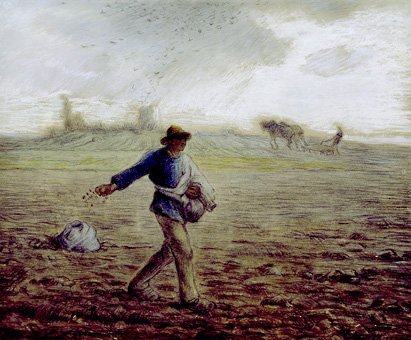
Le semeur
ca. 1865 - 43 x 53 cm - Pastel and coloured pencil on paper
Walters Art Museum, Baltimore, USA >
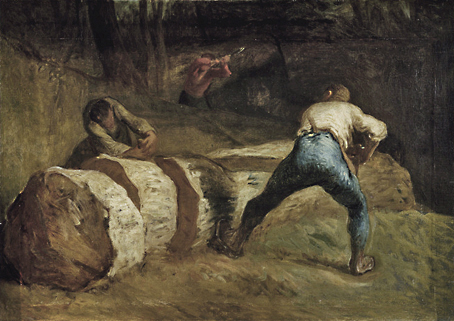
Les scieurs de bois
1850/52 - 57 x 81 cm - Oil on canvas
Victoria & Albert Museum, London, United Kingdom >
Here is another wonderful etching by Jean-François Millet: "The Shepherdess", created in 1862.
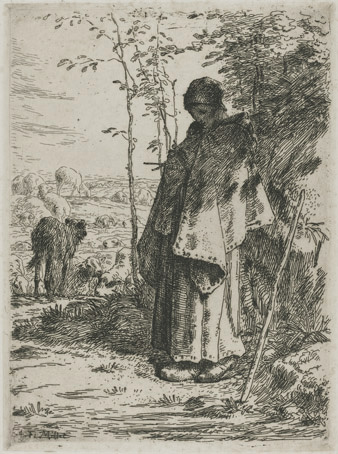
La Grande Bergère
1862 - 32 x 24 cm - Etching in brown ink on laid paper
You have to bear in mind that the contemporary public found the "freedom of execution" of this paper highly disconcerting, sometimes shocking. This is probably no longer quite comprehensible today...
Incidentally, Max Liebermann held the Barbizon painters in high esteem and visited Millet in 1874, shortly before his death in 1875.
Ingres / Delacroix |
Gustave Courbet |
|
|---|---|---|
Imprint |